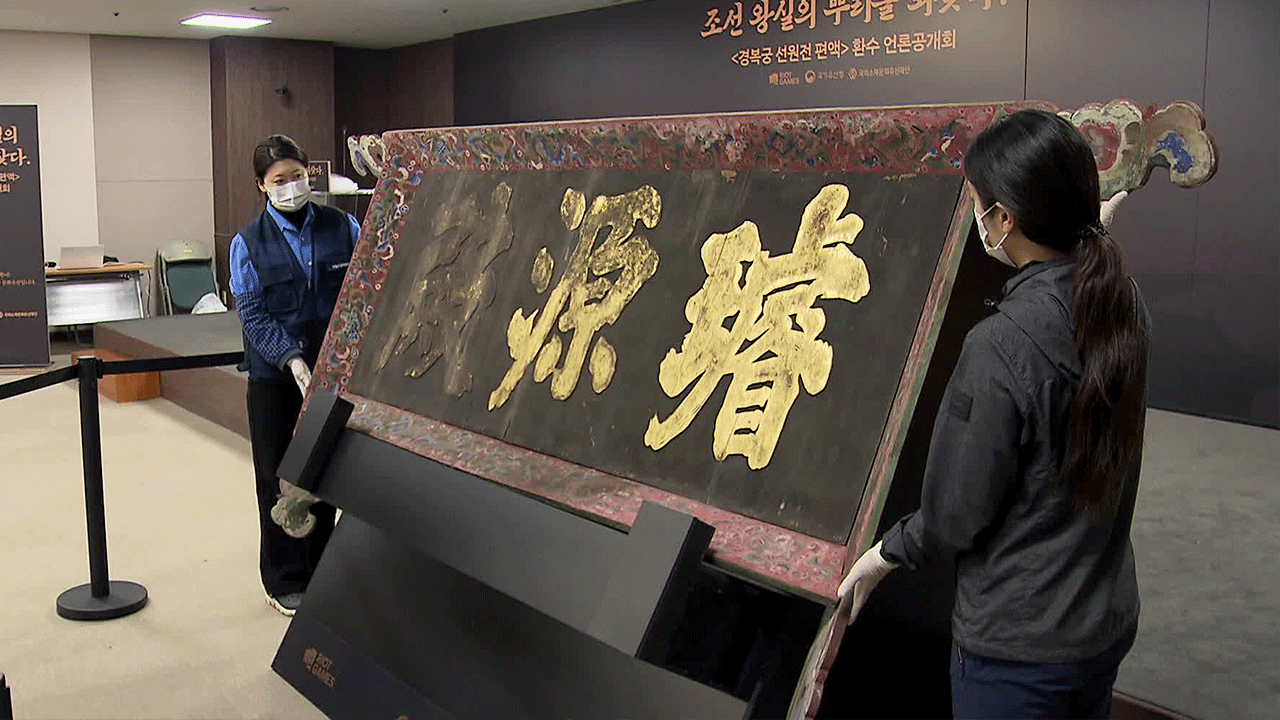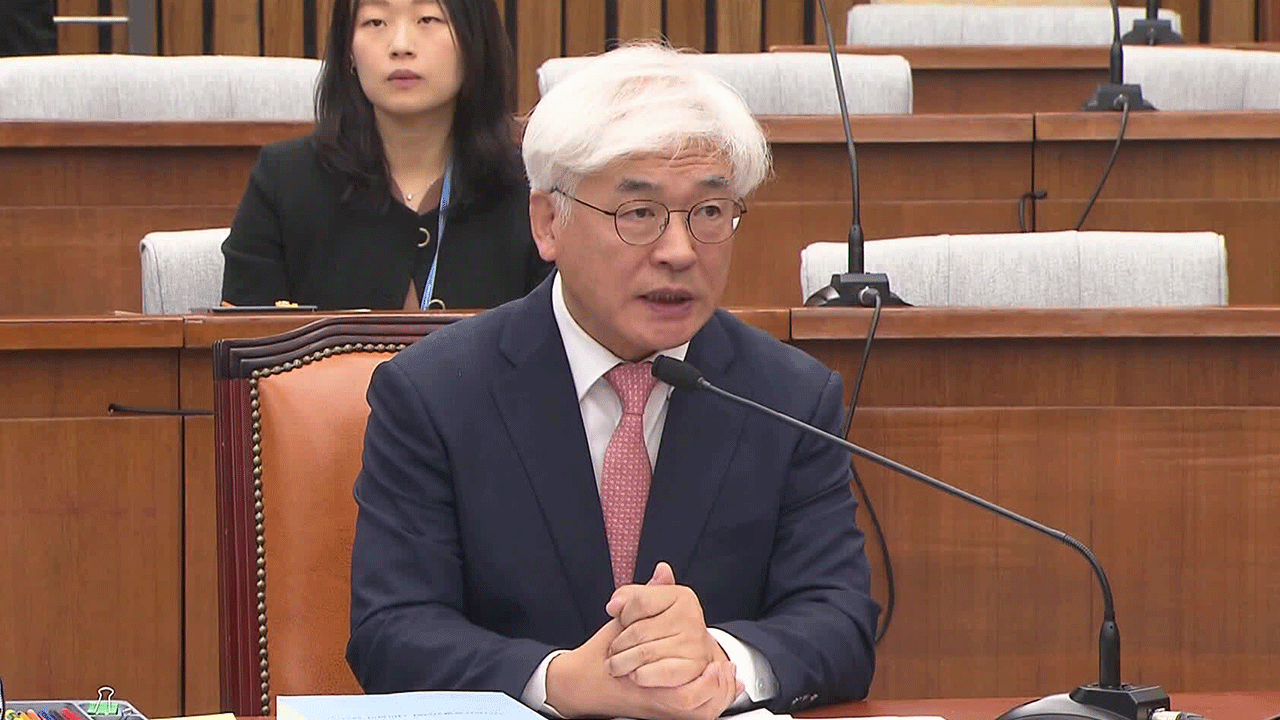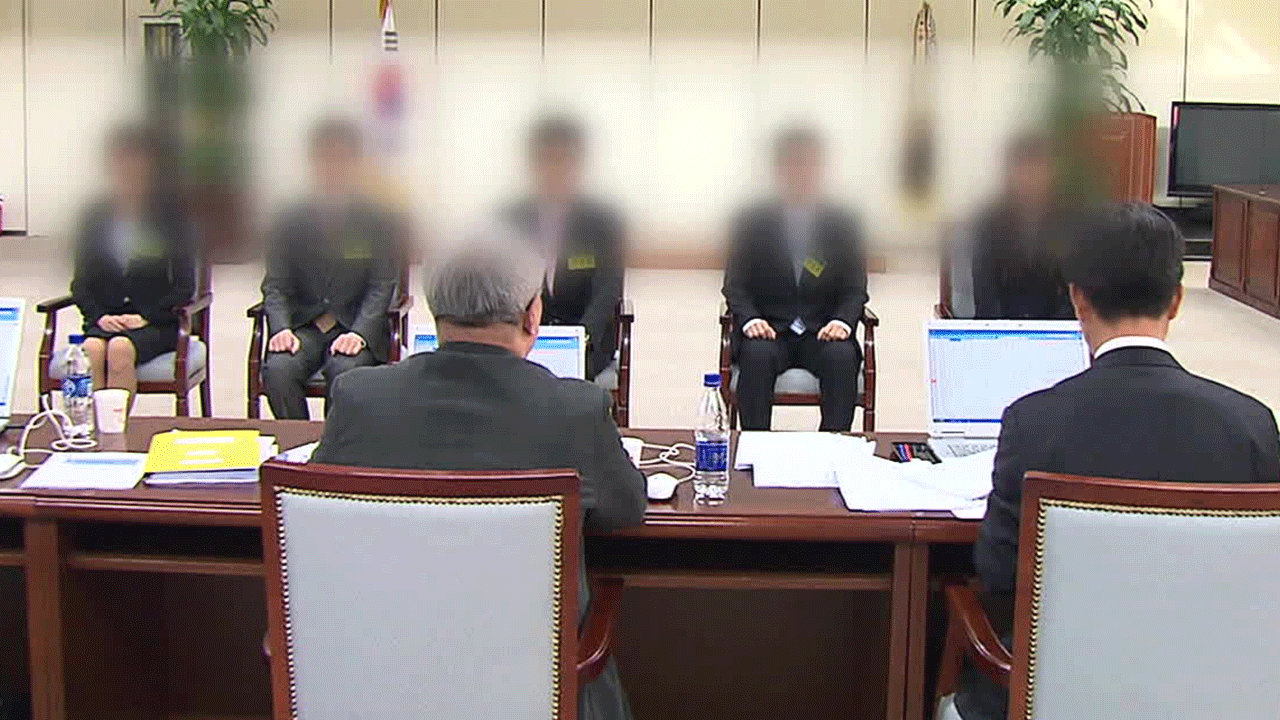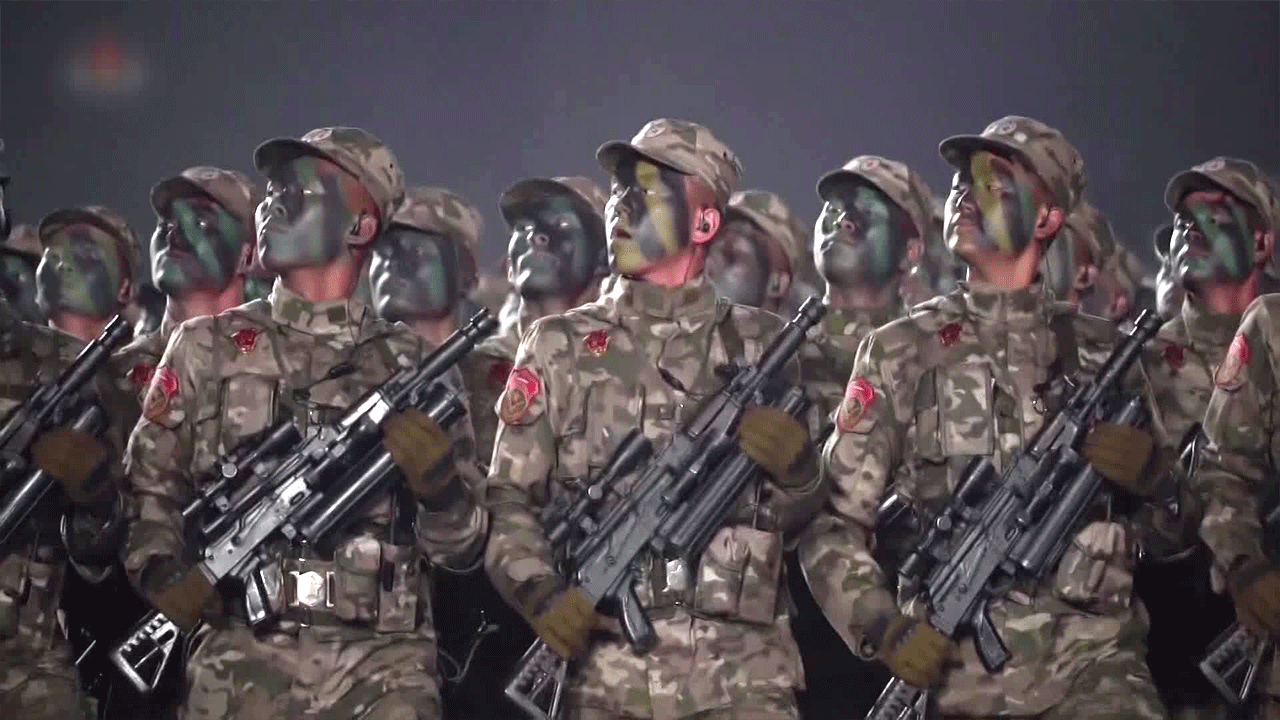[Anchor]
Inside Gyeongbokgung Palace, there is a place called 'Seonwonjeon' where the portraits of the kings from the Joseon Dynasty were enshrined.
It was damaged during the Japanese colonial period and now only exists in records.
However, a plaque that served as the nameplate for Seonwonjeon has returned to the country after 100 years.
Reporter Kim Hye-joo has the details.
[Report]
Seonwonjeon is the most revered space within Gyeongbokgung Palace.
It is the place where the portraits of the late kings, known as eojin, were enshrined, and it was a site of worship for the kings as well.
Immediately after Japan seized our national sovereignty, Seonwonjeon was demolished and damaged, with some of the materials used to build a shrine for Ito Hirobumi.
The plaque that served as the nameplate for Seonwonjeon has returned to its homeland after 100 years.
The words 'Seonwonjeon' are clearly inscribed in gold on a black background.
As it was highly regarded within the palace, it is both large and elaborately decorated.
Two years ago, just before it was to be auctioned in Japan, the Korea Heritage Service, with the support of a domestic game company, managed to persuade the owner to return it.
[Seo Jun/Former Cultural Heritage Specialist at Korea Heritage Service: "This is the first time that a relic of the Joseon royal family has been returned through negotiations like this."]
It is only speculated that it flowed to Japan as Gyeongbokgung was demolished, but the exact timing and route of its export are unknown.
It is briefly mentioned only in the personal records of the first Governor-General of Korea.
[Kim Seong-yeon/Director of the Kurushima Takehiko Memorial Hall: "(The Japanese owner) said, 'I thought it was a very precious historical item, and if I threw it away, I would be cursed. I hung it upside down on a beam so it would never get wet again.'"]
The Korea Heritage Service plans to conduct research on the export route while also carrying out preservation work.
Among the more than 240,000 cultural heritage items that have not been returned after being exported overseas, it is estimated that 40% are in Japan.
This is KBS News, Kim Hye-joo.
Inside Gyeongbokgung Palace, there is a place called 'Seonwonjeon' where the portraits of the kings from the Joseon Dynasty were enshrined.
It was damaged during the Japanese colonial period and now only exists in records.
However, a plaque that served as the nameplate for Seonwonjeon has returned to the country after 100 years.
Reporter Kim Hye-joo has the details.
[Report]
Seonwonjeon is the most revered space within Gyeongbokgung Palace.
It is the place where the portraits of the late kings, known as eojin, were enshrined, and it was a site of worship for the kings as well.
Immediately after Japan seized our national sovereignty, Seonwonjeon was demolished and damaged, with some of the materials used to build a shrine for Ito Hirobumi.
The plaque that served as the nameplate for Seonwonjeon has returned to its homeland after 100 years.
The words 'Seonwonjeon' are clearly inscribed in gold on a black background.
As it was highly regarded within the palace, it is both large and elaborately decorated.
Two years ago, just before it was to be auctioned in Japan, the Korea Heritage Service, with the support of a domestic game company, managed to persuade the owner to return it.
[Seo Jun/Former Cultural Heritage Specialist at Korea Heritage Service: "This is the first time that a relic of the Joseon royal family has been returned through negotiations like this."]
It is only speculated that it flowed to Japan as Gyeongbokgung was demolished, but the exact timing and route of its export are unknown.
It is briefly mentioned only in the personal records of the first Governor-General of Korea.
[Kim Seong-yeon/Director of the Kurushima Takehiko Memorial Hall: "(The Japanese owner) said, 'I thought it was a very precious historical item, and if I threw it away, I would be cursed. I hung it upside down on a beam so it would never get wet again.'"]
The Korea Heritage Service plans to conduct research on the export route while also carrying out preservation work.
Among the more than 240,000 cultural heritage items that have not been returned after being exported overseas, it is estimated that 40% are in Japan.
This is KBS News, Kim Hye-joo.
■ 제보하기
▷ 카카오톡 : 'KBS제보' 검색, 채널 추가
▷ 전화 : 02-781-1234, 4444
▷ 이메일 : kbs1234@kbs.co.kr
▷ 유튜브, 네이버, 카카오에서도 KBS뉴스를 구독해주세요!
- Return of sacred nameplate
-
- 입력 2025-02-28 00:43:12

[Anchor]
Inside Gyeongbokgung Palace, there is a place called 'Seonwonjeon' where the portraits of the kings from the Joseon Dynasty were enshrined.
It was damaged during the Japanese colonial period and now only exists in records.
However, a plaque that served as the nameplate for Seonwonjeon has returned to the country after 100 years.
Reporter Kim Hye-joo has the details.
[Report]
Seonwonjeon is the most revered space within Gyeongbokgung Palace.
It is the place where the portraits of the late kings, known as eojin, were enshrined, and it was a site of worship for the kings as well.
Immediately after Japan seized our national sovereignty, Seonwonjeon was demolished and damaged, with some of the materials used to build a shrine for Ito Hirobumi.
The plaque that served as the nameplate for Seonwonjeon has returned to its homeland after 100 years.
The words 'Seonwonjeon' are clearly inscribed in gold on a black background.
As it was highly regarded within the palace, it is both large and elaborately decorated.
Two years ago, just before it was to be auctioned in Japan, the Korea Heritage Service, with the support of a domestic game company, managed to persuade the owner to return it.
[Seo Jun/Former Cultural Heritage Specialist at Korea Heritage Service: "This is the first time that a relic of the Joseon royal family has been returned through negotiations like this."]
It is only speculated that it flowed to Japan as Gyeongbokgung was demolished, but the exact timing and route of its export are unknown.
It is briefly mentioned only in the personal records of the first Governor-General of Korea.
[Kim Seong-yeon/Director of the Kurushima Takehiko Memorial Hall: "(The Japanese owner) said, 'I thought it was a very precious historical item, and if I threw it away, I would be cursed. I hung it upside down on a beam so it would never get wet again.'"]
The Korea Heritage Service plans to conduct research on the export route while also carrying out preservation work.
Among the more than 240,000 cultural heritage items that have not been returned after being exported overseas, it is estimated that 40% are in Japan.
This is KBS News, Kim Hye-joo.
Inside Gyeongbokgung Palace, there is a place called 'Seonwonjeon' where the portraits of the kings from the Joseon Dynasty were enshrined.
It was damaged during the Japanese colonial period and now only exists in records.
However, a plaque that served as the nameplate for Seonwonjeon has returned to the country after 100 years.
Reporter Kim Hye-joo has the details.
[Report]
Seonwonjeon is the most revered space within Gyeongbokgung Palace.
It is the place where the portraits of the late kings, known as eojin, were enshrined, and it was a site of worship for the kings as well.
Immediately after Japan seized our national sovereignty, Seonwonjeon was demolished and damaged, with some of the materials used to build a shrine for Ito Hirobumi.
The plaque that served as the nameplate for Seonwonjeon has returned to its homeland after 100 years.
The words 'Seonwonjeon' are clearly inscribed in gold on a black background.
As it was highly regarded within the palace, it is both large and elaborately decorated.
Two years ago, just before it was to be auctioned in Japan, the Korea Heritage Service, with the support of a domestic game company, managed to persuade the owner to return it.
[Seo Jun/Former Cultural Heritage Specialist at Korea Heritage Service: "This is the first time that a relic of the Joseon royal family has been returned through negotiations like this."]
It is only speculated that it flowed to Japan as Gyeongbokgung was demolished, but the exact timing and route of its export are unknown.
It is briefly mentioned only in the personal records of the first Governor-General of Korea.
[Kim Seong-yeon/Director of the Kurushima Takehiko Memorial Hall: "(The Japanese owner) said, 'I thought it was a very precious historical item, and if I threw it away, I would be cursed. I hung it upside down on a beam so it would never get wet again.'"]
The Korea Heritage Service plans to conduct research on the export route while also carrying out preservation work.
Among the more than 240,000 cultural heritage items that have not been returned after being exported overseas, it is estimated that 40% are in Japan.
This is KBS News, Kim Hye-joo.
-
-

김혜주 기자 khj@kbs.co.kr
김혜주 기자의 기사 모음
-
이 기사가 좋으셨다면
-
좋아요
0
-
응원해요
0
-
후속 원해요
0













![[단독] “기울어짐 방지 안전 <br>로프 없었다”](/data/news/2025/02/27/20250227_wmN2By.png)

이 기사에 대한 의견을 남겨주세요.